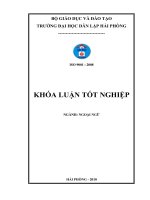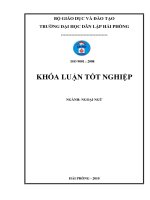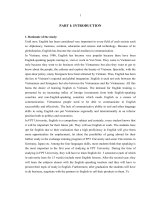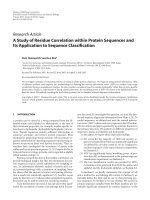a study on malnutritional situation, some relevant factors and proposed solutions to under fives children at viet yen district - bac giang province, 2006-2008
Bạn đang xem bản rút gọn của tài liệu. Xem và tải ngay bản đầy đủ của tài liệu tại đây (193.54 KB, 25 trang )
BACKGROUND
Assessing nutrition status of children provides accurate and
update information not only for malnutrition in children but
also for policy making process.
Malnourished children usually suffer from illness and have
longer time being with the diseases. Malnutrition increases the
risk of suffering from diseases, especially measles and
parasitological diseases. Malnutrition contributes to 61% of
diarrhoea mortality, 57% of pneumonia mortality and 45% of
measles mortality (Black 2005, Bryce 2007) [6], [9]. In return,
malnutrition is a consequence of diarrhoea and acute respitory
infection.
Malnutrition remains as a severe public health problem,
particular in the poor and vulnerable areas such as Bac Giang
province. Although achieved successes in socio-economy and
health care for community, the Bac Giang province still face
difficulties and challenges inclduing malnutrition in children.
In order to contribute to building strategies to address
malnutrition in the poor areas in the future, we propose the
study named “Malnutrition situation, related factors and
solutions for children under 5 years old in Viet Yen district,
Bac Giang province in 2006-2008” to assess the malnutrition
status of children in some mountainous districts, describe
relationships between nutrition status and diet, and determine
1
relationships of nutrition status and intestinal parasitological
infection in children. Then, the appropriate solutions will be
suggested contributing to the malnutrition prevention and
control initiatives in Vietnam.
OBJECTIVES
1. Describe malnutrition status, diet, intestinal
parasitological infections and some usual infections in
children.
2. Determine relationships between malnutrition, diet and
intestinal parasitological infection in children.
3. Assess effectiveness of nutritional interventions in
children under 5 years old in Viet Yen district, Bac
Giang province.
HYPOTHESIS
Poor diets cause malnutrition, and malnutrition and nutritional
anemia are related to the intestinal parasitological infection in
children under 5 years old.
2
CHAPTER 1
LITERATURE REVIEW
1.1. Malnutrition in children
Consequence of hunger is malnutrition [39]. Hunger affects
firstly the vulnerable subjects such as pregnant women,
lactating women and preschool children. These are reflected by
the anthropometric indicators [101]. In field work, researchers
mainly use the anthropometric indicators including weight for
age, height for age and mid-upper arm circumference to
classify the nutritional status [101], [121], [127].
Infants who were born in term with weight under 2,500g are
fetal malnutrition. Fetal malnutrition is the earliest malnutrition
category. In these children, organs such as skin, muscle, bone,
brain, liver and kidney are affected, especially in low birth
weight infants.
1.2. Trend of malnutrition in the world
According to the WHO [227], the current underweight
prevalence of children under 5 years old decreases. From 1975
to 1995, this figure went down from 42.6 % to 34.6%, from
1995 to present (2010) it is at 25%. Decreasing malnutrition in
children under 5 years old was recorded in all regions in the
world. The decrease in Asia is higher than that of other regions
and has significant effect as the most quantity of malnutrition
children used to distribute in the highest density of population.
There is at least two third of malnutrition children residents in
3
Asia a half among them live in 8 countries of Southest Asia is
malnutrition either based on weight for age or weight for height
[73], [132], [157].
Table 1.1. Underweight prevalence by regions among
developing countries from 1975 to 2010 [200].
Regions 1975 1990 1995 2010
%
Mil
%
Mil
%
Mil
%
Mil
Africa
America
Asia
30.4
15.6
47.8
22.9
7.5
164.6
27.3
11.5
41.3
31.6
6.4
154.6
27.0
10.8
40.0
34
6.
158
28.5
8.0
24.0
24.8
5.4
88.3
Under
development
countries
42.6
195.6
35.8
193.4
34.6
199.8
33.6
105.9
Global 34.6
198.6
31.3
195.8
- - 26.0
167.0
The decrease average in 5 year for protein energy malnutrition in
developing countries
%
decreasei
n next 5
years
Period 1975-
1980
1980-
1985
1985-
1990
1990-
1995
1995-
2010
2010-
2015
Decrease
5.2 % 6.2 % 5.5% 3.4% 3.2% 4.3 %
1.3. Trend of malnutrition in children in Vietnam
Table 1.2. Malnutrition of children under 5 years old in Vietnam
in two national nutrition surveys [35], [42]
Time Underweight Stunting
1981-1985 51.5 % 60.9 %
1994 44.9 % 46.9 %
2000 33.8 % 36.5 %
2010 17.5% 29.,3 %
The table 1.2 shows the decrease trend of the malnutrition in
children in Vietnam.
4
Recently, partly as a result from the development of economy
and achievements of the nutrition and health promotion
programs, the rapid decrease in malnutrition prevalence was
determined in many cross sectional studies, particularly in
major cities. However, protein energy malnutrition in children
is still a major challenge for public health in Vietnam. By
1990, prevalence of malnutrition in children went down
significantly, the pace of decrease is remarkable. Although, to
date, malnutrition is still at the high level, especially stunting
and the difference between geographic areas is wide [39].
Additionally, subclinical vitamin A deficiency, iron anemia are
challenging which is more serious in the poor areas [43], [44].
Table 1.4. Recommendation for minerals and vitamins
for children [11]:
Age Minerals Vitamin (mcg)
Calci Fe A B1 B2 PP C
Under 6 months 300 10 325 0,3 0,3 5 30
6-12 months 500 11 350 0,4 0,5 5,4 30
1-3 years 500 6 400 0,8 0,8 9 35
Addressing engery deficiency of these subjects needs to
concern of the capacity of local areas and households which are
the self-supply ability from the VAC model, the low average
income in poor families in rural areas (approximately over
30%).
In conclusion, poverty is the main reason of malnutrition and
the relationship between poverty and malnutrition is
complicated. Nutrition status is both reason and result for the
5
increasing income. Additionally, other factors such as
imbalance diet, poor practice in cooking and preparing foods,
low food hygiene and safety, limited access clean water
resources and health care services are also important.
Malnutrition in children is also affected by other factors.
6
CHAPTER 2
METHODOLOGY
The study was conducted in two stages:
- First stage: Cross-sectional study
- Second stage: Community based intervention
2.1. Subjects:
Inclusion criteria for the cross-sectional study
- Chidlren under 5 years old (0 - 59 months).
- The owners of households and parents of the children
selected.
- Living in the 03 communes selected.
- Willing to particiapte in the study.
2.2. Study site, time of the study:
- The study was conducted in 3 communes (Bich Son,
Nghia Trung and Van Trung) Viet Yen district, Bac Giang
province.
- Time: 03 years, from 2006 to 2008
The study was conducted in Viet Yen district where is bordered
with Bac Ninh provine at the South, Hiep Hoa district at the
West, Yen Dung district at the East, Tan Yen district at the
North.
2.3. Study design
The analytical cross sectional study: determine malnutrition
in children under 5 years old according to places and time,
check blood and check for worm infection.
7
The study was implemented at the household level including
interview the owners, parents of children under 5, and
anthropometric measures for children and their parents.
Simultaneously, check blood and detect for worm infection for
the children selected.
Intervention: community based intervention with case and
control groups for pre and post evaluations.
After conducting the cross sectional study for nutrition status
assessment, the intervention was implemented based on the
results of the previous study in order to select the control and
intervention groups.
2.4. Sample size:
2.4.1. Sample size for cross sectional study
* Sample size for the nutrition status, anemia, intestinal
parasitological infection study:
The number of children need for the cross sectional study was
calculated by the fomular as below [1]:
n = Z
2
* p * (1-p)/ e
2
Including:
n: The number of children needed
Z: level of confidence, with 95%; Z=1.96
p: prevalence of children with infection (malnutrition;
anemia; or intestinal parasitological infection)
e: precision, select 5%.
8
The number of children needed as shown in the table 2.1.
* Sample size for the dietary study:
The fomular:
t
2
* σ
2
* N
n =
e
2
* N + t
2
* σ
2
Including:
n: sample size
t : standard unit (=2 with probability = 0,954)
σ: standard deviation of the estimate energy 300 Kcal
e: deviation (select e=100 Kcal)
N: total children of schools (approximately 600
children/school)
Applying these values into the fomular we had the
number of children need for the dietary survey was 58 children
for each commune.
The total number of children for 3 communes was 174.
Sampling
Select 3 communes for the study, thus the total number of
children for i) Nutrition status survey: 1,200 children; ii)
Aneamia survey: 300 children; iii) Intestinal parasitological
infection survey: 300 children and iv) Diet survey: 174
children.
2.4.2. Sample size for intervention study:
Apply the fomular for difference of mean of observations pre
and post intervention [10]
9
N =
2s
2
(d
1
-d
2
)
2
Including:
+ s: standard deviation of Hb concentration before and
after the intervention. Reference from a study of NIN 2009, s =
7,3 g/L [17].
+ α: Statistical mean, is the probability to get the errors
type 1, select α:= 0.05, coresponding to the precision is 95%.
+ β: probability to get errors type 2, select β = 0,1.
+ Z(α , β ) = 10,5 (coresponding to α = 0.05 and β = 0.1).
+ d1 - d2: the difference of the mean of Hb
concentration between the control and intervention groups,
according to a study of NIN this was d1 - d2: = 4 g/L [17].
Therefore, the sample size needed was 70 children aged 2 - 5
years old for each group. Estimate 20% for lost to follow up we
had the total ò 84 children for each group.
Sampling process and stratification:
After the crosss sectional study stage we conducted the
intervention. The process for sampling and stratification as
below:
- Stratification: Stratification was based on the commune unit.
The study was devided into two groups:
- The control group: Children were supplemented the sugar
condensed milk.
10
- The intervention group: Children were supplemented milk
fortified by micronutrients and deworming tablet.
Before the intervention, subjects were informed the objectives,
requirement, contents; and explained their enquiries if any. All
cases of serious anemia (Hb<70g/dl) detected by the study
were supplemented iron tablets babsed on the MOH Guideline
and excluded to the study. All cases with serious anemia during
the 6 month duration of the study were also treated and
excluded to the study then inform to the local health
department to continuing monitor.
The control and intervention groups were supplied with 200 ml
milk daily, the intervention children (NNC) were supplied 4.1
mg iron, 450 IU vitamin A and 4.6 mg zinc and other
micronutrients such as group B vitamins, vitamin C and
deworming each 6 months under supervision. Time for
intervention was 6 months. It was single blinding technique.
11
CHAPTER 3
RESULTS
3.1. Status of malnutrition in children
Nutritional status of children
Figure 3.1. Nutrition status of children under 5 years old
Figure 3.1 shows the prevalence of malnutrition in children
under 5 for underweight, stunting and wasting was at severe
level based on the classification of WHO (respectively were
24.6%, 34.7% and 9.2% for 3 communes).
Table 3.2. Malnutrition in children under 5 in 3 communes
compared to the data of the Bac Giang province in 2007
Data 2007 Underweight Stunting Wasting
Bac Giang
(NIN-2007)
23.9
(CI: 21.9-
25.9)
36.2
(CI: 34.3-
38.1)
8.1
(CI: 7.4-
8.8)
3 studied
communes in
2007
24.6
(CI: 21.7-
27.5)
34.7
(CI: 31,8-
37.6)
9.2
(CI: 7.9-
10.5)
12
* Source: NIN, 2007 in the Health Statistical Year Book 2008.
The prevalence of malnutrition in children under five years old
in three communes in Viet Yen district is at severe level as that
of Bac Giang province.
a) Malnutrition status of children under 5 according to
communes.
Table 3.3. Malnutrition in children under 5 years old
based on communes
Malnutrition
Places
Bích Sơn
commune
(n=400)
Vân
Trung
commune
(n=400)
Nghĩa
Trung
commune
(n=400)
Total
(n=1200)
Weight/age (%)
21.8 24.7 26.7 24.6
CI 95% (20.1-
23.5)
(21.9-
27.5)
(24.5-
28.9)
(21.7-
27.5)
Height/age (%)
37.5 28.7 38.9 34.5
CI 95% (32.1-
42.6)
(24.1-
33.3)
(34.1-
43.4)
(31.8-
37.6)
Weight/height
(%)
9.4 8.9 9 9.4
CI 95% (7.8-
10.6)
(6.9-
10.9)
(7.7-
10.3)
(7.9-
10.5)
Table 3.3 indicates the malnutrition prevalence in children for
underweight, stunting and wasting varied in 03 surveyed
communes, and this vary for undeweight and stunting was not
significant difference (CI 95%). Meanwhile the prevalence of
wasting in the lowest and highest communes had changed at
statistically siginificant difference (p<0,5).
b) Anemia in children under 5 years old
13
Table 3.4. Anemia in children under 5 in 3 communes
Places
Bich Son
commune
(n=100)
Van
Trung
commune
(n=100)
Nghia
Trung
commune
(n=100)
Total
(n=300)
Prevalence
and CI 95%
based on
communes
28,1 ± 3,4 23,7 ± 3,6 34,4 ± 4,1 28,7 ±
3,5
Table 3.4 showes the anemia prevalence in children was at the
serious level according to the classification of WHO.
3.1.3. Dietary intake of children:
- Rice: is the main food, the average intake was 191.6
g/child/day; the highest intake was 215.3 g/child/day. The
average intake of other staple foods was 19 g/child/day, of
those corn and sweet potato accounted for the highest
proportion.
- Rice was consumed most by the stunting children
(201g/day). This level was not different between underweight
and normal children.
Rice intake of children aged 25-35 months was 172g/day,
aged 36-59 months was 202g/day (figure 3.3).
Average of bean nuts intake was 10g/day. Soy bean
which is one of the good sources of protein with cheap price,
but was not paid attention on diet for children (5.11 g/day).
14
- Animal food (excluding milk) intake on average was
110g/child/day, which was mainly from meat
(42.2g/capita/day), fish (42 g/day) and egg (15.9g/child/day).
- Milk was consumed by children aged 2-5 years old at
the level of 143.5 ml/day. The protein provided 17% the total
energy from diet and met the recommendations.
- Oil and fat consumption was 3.6 g/day on average.
Table 3.6: Nutritional value of diet
Contents Quantity
Energy (Kcal) 1193
Protein (g)
+ Total 49
+ Animal 27
Lipit (g)
+ Total 25
Nutrients 3
Ca (mg) 461
P (mg) 676
Fe (mg) 7
Zn (mg) 6
Vitamin A (mcg) 192
Vitamin B1(mg) 1
Vitamin B2 (mg) 1
Vitamin PP (mg) 9
Vitamin C (mg) 45
Bio. Iron (mg) 0,9
15
The rate of energy from fat in diet was at 25% on average, met
the recommendations for balance of diet for children at the
cohort, of those, energy provided from fat was ≤ 20% which
caused imbalanced diet and particularly not ensure the
resources of fatty acid for growth and development of
children’s brain. Iron intake met 59% the recommendation for
the children in cohort.
Table 3.8. The average of energy intake compared to the
recommendations for children 24-59 months
Contents Age categories
24-35 months 36-59 months
n = 125 n = 224
Energy (%) 98 91
Vitamin A (%) 88 85
Vitamin B1(%) 109 89
Vitamin B2 (%) 138 99
Vitamin PP(%) 101 89
Vitamin C (%) 63 63
Iron (%) 56 87
The needs for protein was met does not mean the diet is
sufficient quantity of nutrients and balanced quality,
particularly for micronutrients. Improving height of the
Vietnamese is a challenged target as the meeting of the
16
recommendations for iron of children aged 24-35 months was
at 56% and it was 87% for the children aged 36-59 months.
17
Table 3.9. The average of energy intake compared to the
recommendations for children 24-59 months calssified by
malnutrition categories
Contents
Underweight
n = 672
Stunting
n = 528
Energy (%) 79 83
Vitamin B1(%) 70 72
Vitamin B2 (%) 72 75
Vitamin C (%) 47 57
Iron (%) 60 62
Vitamin A (%) 55 49
Vitamin PP(%) 75 72
Calcium (%) 93 88
The meet with the recommendations for nutrients of
underweight children was lower than that in the sunting
children. The lack was more severe for particular
micronutrients such as vitamin C, iron, vitamin A (the response
was from 47% for vitamin C in stunting children to 62% for
iron) in underweight children.
3.2. Acute respiratory infection, diarrhoea and intestinal
parasitological infection in children
Table 3.19: Fever and cough of children in the last 3 months
Symptoms
Percentage
Bich Son
commune
(n = 400)
Van Trung
commune
(n= 400)
Nghia
Trung
commune
(n= 400)
Total
(n = 1200)
Fever 54,7 51,5 57,8 54,5
Cough 76,6 64,4 81,1 73,3
18
The prevalence of children with fever was high. There was
greater a half (54,5%) of children in three communes with
fever within the last three months.
3.2.2. Intestinal infection
There were greater than 36% of the children getting diarrhoea
for the last 3 months, which was higher than that in the
Northern areas. There were 86% of the mothers taking their
children to health facilities for diarrhoea treatment; and 11.3%
mothers treated their children at home.
3.3. Risk factors of malnutrition in children
3.4. Effectiveness of the intervention.
(As the intervention was conducted in a short time, the sutdy
only assess the mean of change of the WAZ scores and HAZ-
scores as below)
Table 3.26. Nutrition status before the intervention
Contents
Intervention
group X ± SD
(n = 81)
Control group X ±
SD
(n = 162)
p
Before After Before After
Average
WAZ-
score
- 1,548
± 1,561
- 1,314
± 0,887
- 1,656
± 0,885
- 1,676 ±
0,920
>0,05
p <0,05 p >0,05
Average
HAZ-
score
- 1,552
± 1,590
- 1,265
± 0,900
- 1,785
± 1,037
- 1,734 ±
0,977
>0,05
p <0,05 p >0,05
19
In the intervention group, the average of weight for age (WAZ
score) was - 1,314 ± 0,887 after the intervention which was
significant difference compared to those before the
intervention (p<0,05). In the control group, the average of
weight for age (WAZ score) was- 1,676 ± 0,920, which
showed no differencecompared to those before the intervention
(p>0,05).
In the intervention group, the average height for age
(HAZscore) after the intervention was -1,265 ± 0,900,
significant difference compared to those before the
intervention (p<0,05). In the control group, the average height
for age (HAZscore) after the intevention was -1,734 ± 0,977,
which had no difference compared to those before the
intervention (p>0,05).
Table 3.29. Change of Hb before and after the intervention
Contents Intervention
group X ± SD
(n = 81)
Control group X
± SD (n = 162)
p
Hb
(g/100mL)
11,360 ±
1,192
12,937
± 1,834
11,554 ±
1,346
11,840
± 1,282
>0,05
p <0,01 p >0,05
Change of
Hb on
average
1,577 ± 1,714 0,285 ± 1,383 0,001
Average
Ferritin
(µmg/L)
50,680 ±
34,862
66,235
±
42,479
44,812 ±
29,352
47,701
±
33,574
>0,05
p <0,05 p >0,05
Change of
Ferritin
15,555 ± 28,372 2,889 ± 21,880 0,001
20
For the serum ferritin indicator, it increased from 50,680 ±
34,862 µg/L to 66,235 ± 42,479 µg/L after the intervention in
the intervention group (p<0,05), the mean of change was
15.555± 28.372 µg/L. This increase of the serum ferritin was
significant between the control and intervention groups with
p<0,01.
In the control group, the mean of serum ferritin after the
intervention was 47,701 ± 33,574 µg/L, no significant
difference compared to before the intervention (p>0,05).
21
CHAPTER 4
DISCUSSION
4.1. Features of nutritional status and dietary intake of
children at the studied sites: Distribution of malnutrition
and anemia.
In general, the prevalence of underweight was at the high level
according to the classification of WHO (>20%). It was similar
to the prevalence of sunting at the Bich Son and Nghia Trung
communes (>30%), while the prevalence of stunting in the Van
Trung commune was at the medium level (between >20% and
<30%). The prevalence of wasting in 3 communes was medium
(5-9,9%).
4.2. Effectiveness of intervention.
4.2.1. Nutrition
In the neonatal time, the fetal malnutrition children who get
chronic infection or are malnourished, particularly energy,
protein, vitamin A, zinc, iron will be under development and
more severity. Underweight children often get diarrhoea and
pneumonia. There is a positive relationship between severity
of malnutrition and mortality in children. In 1995, estimately,
there were 11.6 million children under 5 in developing
countries died because of all causes including 6.3 million cases
(54%) due to underweight. Almost children died had symptoms
in relation to underweight.
4.2.2. Anemia
22
The results showed that, the intervention group had an increase
of Hb concentration from 11.36 ±1.192 g/dL to 12.94±1.83
g/dL (p<0.001), increase on average of 1.58 ± 1.71 g/dL. This
rise was significant between the groups with p<0.001. The
figure in the control group was 11.84± 1.28 g/dl after the
intervention time, has no significance (p>0.05). Thus, we can
conclude that supplementation of milk fortified with
micronutrients may improve anemia indicators for children.
CONCLUSION
The results of the study show that:
1. Nutritional status and related factors
- The prevalence of underweight, stunting and wasting of
children under five years old were at high level according to
the classification of the WHO (respectively were 24.6%, 34.7%
and 9.2% for three communes).
- The prevalence of nutrtional anemia of children was
severe according to the classification of the WHO. The
prevalence for 3 communes was 28.7%.
- Diet of children was poor, the main food was rice and
vegetable, added kinds of source, dried fish and prawn which
caused a lack of nutrients, particualrly micronutrients.
- Knowledge of people about anemia was limited.
Approximate a half mothers could indicate one of the reasons
for anemia was malnutrition
23
- The prevalence of worm infection was 28.7% for 3
communes. Worm infection closely related to malnutrition and
anemia.
2. Effectiveness of the intervention
- The HAZ-scores statistically significant increased.
Similarly, WAZ-score rose much more in the intervention
group compared to the control group after 6 months of
intervention.
- The concentration of Hb increased significant in the
intervention group from 11.36 ±1.192 g/dL to 12.94±1.83 g/dL
(p<0.001), the average rise was 1.58 ± 1.71 g/dL. The increase
of Hb concentration was significant difference between the
intervention and control groups (p<0.,001). Therefore, we can
conclude that supplementation of milk fortified micronutrients
reduces the aneamia and improves the iron status indicators in
children.
24
RECOMMENDATION
1. Improve knowledge, attitude, and practice in
parasitological infection prevention by nutritional and health
care education and communication programs.
2. Integrate, coordinate the parasitological infection
prevention programs with health care, clean water supply,
nutritional, children and maternal health protection programs.
3. The model of daily supplementation of milk fortified
micronutrients and deworming and nutritional consultation at
households should be developed in order to prevent
malnutrition in children in the future
4. There is a need to continue the research for food
supplement fortified micronutrients with long term
interventions to demonstrate the effectiveness of nutrition and
health improvement for children as well as the sustainability of
the intervention.
25









